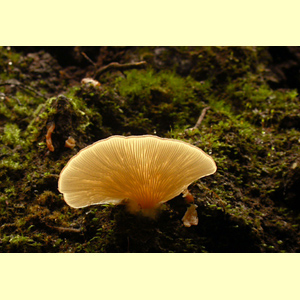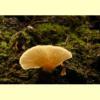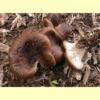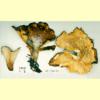
images/Hohenbuehelia/hohenbuehelia.jpg
Small to large agaric, growing on the ground (on buried wood), litter, mulch or wood, with a white spore print. Pileus brown, grey or black, viscid or not. Lamellae adnate or decurrent. True stipe lacking; the attachment to the substrate is excentric, lateral or the fruit-body is sessile. Partial veil remnants absent. Spores hyaline, non-amyloid, smooth; germ pore absent. Cheilocystidia present. Gloeosphex cystidia present. Metuloid cystidia present. Lamellar trama regular or interwoven. Pileipellis a cutis or trichoderm, rarely a hymeniderm. Clamp connections present.
Among white-spored agarics with an excentric to lateral stipe,
Hohenbuehelia is characterised by the rather rubbery texture and greyish brown pileus. Microscopically, the gloeosphex cystidia (with their hourglass-shaped tip enclosed in a droplet) are very characteristic, especially in combination with the metuloid cystidia (thick-walled and crystal-capped). Gloeosphex cystidia are otherwise found only in
Panellus ligulatus (which has small, pale orange-brown fruit-bodies and does not have thick-walled cystidia) and rarely in
Pleurotus (which is fleshy rather than rubbery and lacks thick-walled cystidia, except in
Pleurotus australis, where they are not capped with crystals).
Lentinellus is firm in texture, but has lamellae with a jagged margin and amyloid, warty spores.
Conchomyces has a distinct stipe and spinose spores. The odour of
Hohenbuehelia is often strongly farinaceous.
Hohenbuehelia Schulzer, in Schulzer et al., Verh. K.K. Zool.-Bot. Ges. Wien 16: 45 (1866).
Seven species: Hohenbuehelia atrocaerulea, H. atrolucida, H. bingarra, H. carbonaria, H. clelandii, H. karrara and H. petaloides.
W.A., S.A., Qld, N.S.W., Vic. and Tas. (and probably also N.T.).
In native forests or in pine plantations.
On litter or wood, sometimes appearing terrestrial, but then on buried wood.
Saprotrophic. Also parasitic on nematodes.
Bougher, N.L. (2009a),
Fungi of the Perth region and beyond: a self-managed field book, Western Australian Naturalists' Club (Inc.), Perth. [
Description and
Illustration of
H. bingarra]
Cooke, M.C. (1892), Handbook of Australian Fungi. Williams & Norgate, London. [Description and Illustration of H. carbonaria (as Panus)]
Fuhrer, B. (2005), A Field Guide to Australian Fungi. Bloomings Books, Hawthorn. [Description and Illustration of H. atrocaerulea, H. clelandii, H. petaloides and an unnamed species]
Grgurinovic, C.A. (1997a), Larger Fungi of South Australia. The Botanic Gardens of Adelaide and State Herbarium and The Flora and Fauna of South Australia Handbooks Committee, Adelaide. [Key to South Australian species, and Description and Microcharacters of H. bingarra, H. clelandii and H. karrara, along with Illustration of H. clelandii]
McCann, I.R. (2003), Australian Fungi Illustrated. Macdown Productions, Vermont. [Illustration of several unnamed species]
Pegler, D.N. (1965), Studies on Australasian Agaricales, Austral. J. Bot. 13: 323–356. [Microcharacters of H. carbonaria]
Pegler, D.N. (1983b), The genus Lentinus: a world monograph, Kew Bull., Addit. Ser. 10: 1–281. [Description, B&W Illustration and Microcharacters of H. atrolucida]
Thorn, R.G. & Barron, G.L. (1986), Nematoctonus and the tribe Resupinateae in Ontario, Canada, Mycotaxon 25: 321–453. [Description, B&W Illustration and Microcharacters of H. atrocaerulea, and a generic description and comprehensive information for ten other species of Hohenbuehelia]





